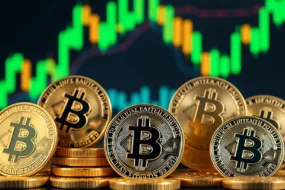
In the ever-evolving world of digital finance, cryptocurrencies have taken center stage as revolutionary assets in the modern financial landscape. Whether you’re a seasoned crypto enthusiast or a newcomer looking to dive into the digital currency realm, this article will provide valuable insights into top 10 cryptocurrencies.
Here is a table featuring the top 10 cryptocurrencies as of Jan 2024, along with their market capitalization, highest price, and lowest price:
| Cryptocurrency | Market Cap (USD) | Highest Price (USD) | Lowest Price (USD) |
| Bitcoin (BTC) | $458 billion | $68,789 | $34,630 |
| Ethereum (ETH) | $216 billion | $5,995 | $3,084 |
| Tether (USDT) | $66 billion | $1.03 | $0.96 |
| USD Coin (USDC) | $54 billion | $1.02 | $0.99 |
| Binance Coin (BNB) | $52 billion | $577 | $365 |
| Ripple (XRP) | $18 billion | $1.49 | $0.78 |
| Cardano (ADA) | $18 billion | $2.40 | $1.20 |
| Binance USD (BUSD) | $18 billion | $1.03 | $0.99 |
| Solana (SOL) | $15 billion | $180 | $85 |
| Polkadot (DOT) | $10 billion | $48 | $22 |
1. Bitcoin (BTC)
Market Cap: $458 billion
Bitcoin (BTC) is renowned for introducing blockchain technology, offering decentralized, secure, and transparent financial transactions. Bitcoin’s limited supply, capped at 21 million coins, and its halving events (which reduce mining rewards by half approximately every four years) play crucial roles in influencing its value.
In Jan 2024, Bitcoin saw the approval of Bitcoin Spot Exchange-Traded Funds (ETFs), enhancing its accessibility and legitimacy among mainstream investors. These ETFs allow a broader range of investors to gain exposure to Bitcoin without the complexities of direct cryptocurrency ownership.
These advancements, alongside Bitcoin’s inherent features, continue to position it as a vital player in the evolving landscape of digital currencies.
2. Ethereum (ETH)
Market Cap: $216 billion
Ethereum is the second-largest cryptocurrency by market capitalization.
It introduced smart contracts, enabling complex decentralized applications.
Ethereum is transitioning from Proof of Work (PoW) to Proof of Stake (PoS) to reduce energy consumption and improve scalability.
It supports a large ecosystem of decentralized applications (dApps) and decentralized finance (DeFi) platforms.
Ethereum’s native token, Ether (ETH), is used for transaction fees and computational services on the network.
Ethereum’s robust smart contract functionality and its widespread adoption in the DeFi and NFT sectors make it a foundational platform in the blockchain space.
3. Tether (USDT)
Market Cap: $66 billion
Tether is the largest stablecoin by market capitalization, which was nearing $100 billion as of early 2024.
USDT is pegged to the US dollar, aiming to maintain a 1:1 value ratio.
It operates on multiple blockchains, including Ethereum and Tron.
Tether plays a crucial role in the cryptocurrency ecosystem, providing a stable value store and a bridge between traditional finance and crypto markets.
It has faced scrutiny over the years regarding its reserves and the true backing of its USDT tokens. Despite allegations by a United Nations agency of USDT being used for illicit activities in parts of Asia, Tether has denied these claims, stating that using USDT for such purposes is difficult due to its collaboration with law enforcement agencies.
Tether’s peg to the US dollar and widespread acceptance across major cryptocurrency exchanges make it a preferred choice for traders and investors seeking stability in the highly volatile crypto market.
4. USD Coin (USDC)
Market Cap: $54 billion
USD Coin (USDC) is a significant player in the stablecoin market, known for its stability and widespread use across various blockchain networks.
USDC is a fiat-backed stablecoin pegged to the U.S. dollar on a 1:1 basis.
It is available as an ERC-20 token, making it interoperable with Ethereum-based decentralized applications (DApps).
Beyond Ethereum, USDC is compatible with other major blockchain networks like Solana, Avalanche, TRON, Algorand, Stellar, Flow, and Hedera.
USDC tokens are created via a smart contract each time a dollar is deposited. Each token is redeemable for one dollar.
The token’s issuance and redemption are governed by compliance with Anti-Money Laundering standards and the Financial Action Task Force requirements.
USDC’s main appeal is its stability and transparency, being audited by reputable firms like Deloitte. It is widely used for instant global payments, purchasing goods and services, and for lending and borrowing on decentralized finance (DeFi) platforms without the need for third-party intervention.Its integration across multiple blockchain networks expands its usability and accessibility within the crypto ecosystem.
5. Binance Coin (BNB)
Market Cap: $52 billion
Binance Coin (BNB) is the native cryptocurrency of the Binance cryptocurrency exchange, one of the largest exchanges in the world by trading volume.
BNB was initially based on the Ethereum blockchain as an ERC-20 token but later moved to Binance’s own blockchain, the Binance Chain. It is widely used within the Binance ecosystem, particularly to pay for trading fees at a discounted rate.
Recently, the U.S. Securities and Exchange Commission (SEC) is investigating whether the initial coin offering (ICO) of Binance Coin should have been registered as a security.
BNB has been a top-performing cryptocurrency in terms of market capitalization. Despite market fluctuations, it has consistently maintained a strong position among the leading digital currencies.
6. Ripple (XRP)
Market Cap: $18 billion
Ripple (XRP), with a market cap of $18 billion as of January 2024, is a prominent digital asset known for its utility in international transactions and remittances. It’s backed by Ripple Labs, a San Francisco-based company focusing on facilitating cross-border payments.
Recent developments include Ripple Labs transferring millions of XRP tokens, which raised questions about potential market impacts. These transfers occurred during an upward movement in XRP’s value, leading to speculation about asset dumping.
XRP’s uniqueness lies in its design for fast and cost-effective cross-border money transfers, setting it apart from other cryptocurrencies primarily used for investment or decentralization purposes. However, it’s essential to consider Ripple’s ongoing legal and regulatory challenges, especially with the U.S. Securities and Exchange Commission (SEC), which could influence its future utility and market value.
7. Cardano (ADA)
Market Cap: $18 billion
Cardano (ADA) is a prominent blockchain platform known for its research-driven approach and emphasis on sustainability and scalability. It is built on a proof-of-stake protocol, offering a more energy-efficient alternative to traditional proof-of-work systems.
As of January 2024, some significant developments in the Cardano ecosystem include the burning of a substantial portion of the Minswap token supply, a leading Decentralized Exchange (DEX) on Cardano, and the introduction of Indigo protocol’s iAssets. These synthetic assets track the price of real-world and digital assets, indicating Cardano’s expansion into tokenizing various asset classes.
Furthermore, Cardano’s partnership with Petrobras, a Brazilian state-owned energy company, highlights its educational initiatives and expansion in South America.
Cardano’s use cases are diverse, ranging from creating decentralized applications (dApps) and smart contracts to facilitating digital identity and microfinance. Its technology is designed for a high degree of security and scalability, making it suitable for various real-world applications.
The platform’s unique approach to blockchain technology, focusing on peer-reviewed research and methodical development, sets it apart in the crypto space.
8. Binance USD (BUSD)
Market Cap: $18 billion
Binance USD (BUSD) is a stablecoin, which means it is a type of cryptocurrency that aims to maintain a stable market price. It is pegged to the US dollar, meaning its value is intended to be equivalent to that of the US dollar. The use cases of BUSD, like other stablecoins, primarily revolve around providing a stable medium of exchange in the volatile cryptocurrency market. It can be used for trading, remittances, payments, and as a stable store of value. As of January 2024, there have been significant developments concerning BUSD.
Firstly, Binance announced that it would be phasing out support for BUSD. This move involved the automatic conversion of any remaining BUSD balances in users’ Binance accounts to a new stablecoin, FDUSD, at a 1:1 conversion rate. This change was implemented following regulatory scrutiny and challenges faced by BUSD, particularly actions taken by the US Securities and Exchange Commission (SEC) against Binance and Paxos, the issuer of BUSD.
Furthermore, the market capitalization of BUSD has seen a notable decline. In a month, BUSD’s circulating supply fell from $17.4 billion to $15.4 billion. This reduction in supply is part of the broader challenges and shifts in the stablecoin market, with competitors like USDC experiencing contrasting fortunes.
9. Solana (SOL)
Market Cap: $15 billion
Solana (SOL) is emerging as a hub for blockchain innovation. The platform has also experienced a 10x growth in developers from 2020 to 2023, highlighting its appeal among new developers in the blockchain space.
In terms of technology, Solana is renowned for its high throughput and low transaction costs, enabled by its unique consensus mechanism combining Proof of History (PoH) with Proof of Stake (PoS). This combination allows for faster transaction processing, making Solana an attractive option for a range of decentralized applications and services.
Solana is also developing Firedancer, a new validator client, to optimize network components and increase transaction processing capabilities.
Its uniqueness lies in its ability to handle high transaction volumes at low costs, making it a competitive platform for both developers and users.
10. Polkadot (DOT)
Market Cap: $10 billion
Polkadot (DOT) has a unique blockchain protocol designed to enable Web3 and decentralized applications (dApps) through a network of interconnected blockchains.
The Polkadot ecosystem is known for its focus on interoperability, allowing different blockchains to communicate and share information securely. This feature is facilitated through its innovative architecture, which includes a main relay chain and various parachains. Each parachain can have its own tokens and operate with specific use cases, while still being connected to the broader Polkadot network.
The Polkadot ecosystem has recently acquired five new parachain slots by diverse projects. These new parachains cover a range of use cases, such as decentralized autonomous organizations (DAOs), the metaverse, Internet of Things (IoT), and sustainable energy solutions. This expansion demonstrates Polkadot’s growing appeal and versatility across various sectors.
Polkadot’s technical upgrades have been significant and are expected to enhance the platform’s scalability and efficiency. The network’s staking metrics have also been positive, showing a substantial increase in the volume of staked DOT.
For investors and users interested in Polkadot, the combination of its unique interoperability concept, technical advancements, and robust community development make it a compelling project in the blockchain space.
Conclusion –
In conclusion, the crypto market remains as vibrant and dynamic as ever, with the top 10 cryptocurrencies playing pivotal roles in shaping the future of finance. The crypto landscape is constantly evolving, with new projects and developments emerging regularly. Staying informed about these top cryptocurrencies is essential for anyone looking to navigate the world of digital assets successfully. Whether you’re an investor, trader, or simply curious about the future of finance, keeping an eye on the top 10 cryptocurrencies is a valuable endeavor in these exciting times of change and innovation.





